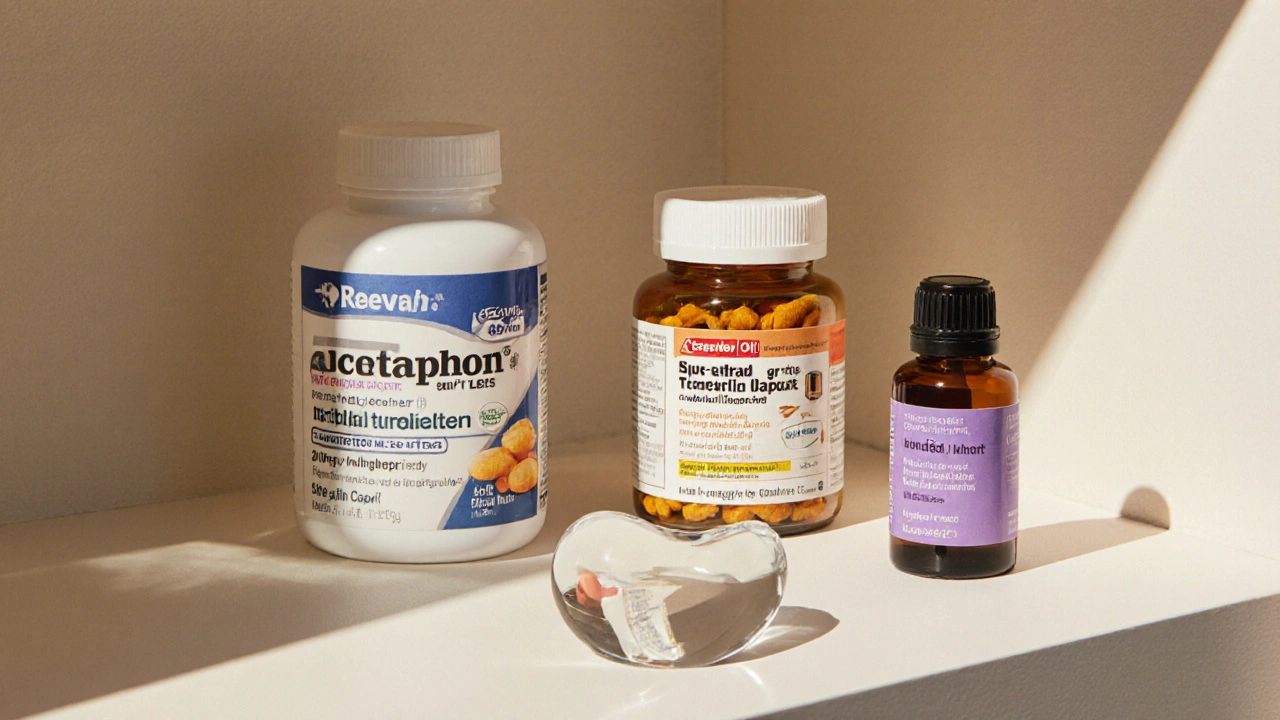Ketorolac Renal Risk Assessment Tool
Patient Information
Quick Take
- Ketorolac can reduce kidney blood flow by blocking prostaglandins.
- People with dehydration, existing kidney disease, or the elderly are most vulnerable.
- Check serum creatinine and eGFR before starting, then every 48‑72hours during treatment.
- Limit use to 5days or less; use the lowest effective dose.
- Consider ibuprofen (short‑term) or acetaminophen for milder pain to protect kidneys.
Every year, thousands of emergency‑room visits end with an IV dose of Ketorolac is a potent non‑steroidal anti‑inflammatory drug (NSAID) that provides fast, opioid‑free pain relief. Ketorolac kidney function is a concern because the drug can silently strain the kidneys, especially in people who already have renal risk factors. This guide explains exactly how the medication interacts with the kidneys, who should stay away, and what you can do to keep your renal health in check.
What Is Ketorolac?
Ketorolac is a short‑acting NSAID used for moderate to severe pain, often after surgery or injury. It works by inhibiting the cyclooxygenase enzymes (COX‑1 and COX‑2), which stops the body from making prostaglandins-chemical messengers that drive inflammation and pain. The drug is usually given as an injection, but oral tablets are also available for short‑term use.
How Kidneys Keep Your Body Balanced
Kidney function refers to the ability of the kidneys to filter blood, excrete waste, and regulate fluid, electrolytes, and acid‑base balance. Each kidney contains about a million nephrons, tiny filtration units that rely on steady blood flow to clear creatinine and other metabolic waste. Prostaglandins act like vasodilators in the renal vasculature, especially during low‑blood‑pressure states, helping maintain adequate glomerular filtration rate (GFR).
Why Ketorolac Can Harm the Kidneys
The link between Ketorolac and renal stress hinges on three biochemical steps:
- COX inhibition: By blocking COX‑1 and COX‑2, Ketorolac reduces the synthesis of prostaglandins that keep the afferent arterioles dilated.
- Reduced renal blood flow: Without prostaglandin‑mediated dilation, the kidneys experience vasoconstriction, especially in the outer medulla where oxygen levels are already low.
- Drop in GFR: The narrowed vessels lower glomerular pressure, decreasing the filtration rate and causing a rise in serum creatinine.
In healthy adults with normal hydration, this effect is usually mild and reversible. However, Prostaglandins are lipid compounds that relax blood vessels and protect renal perfusion are crucial when the body is stressed. Remove them, and the kidneys can quickly become ischemic.
Who Is Most at Risk?
Not everyone who takes Ketorolac will develop kidney problems, but certain groups should be extra cautious:
- Pre‑existing kidney disease: Patients with chronic kidney disease (CKD) already have reduced nephron mass.
- Dehydration: Low fluid volume limits the kidney’s ability to compensate for reduced prostaglandin support.
- Elderly: Age‑related decline in renal mass and GFR makes the kidneys more vulnerable.
- Concurrent nephrotoxic drugs: ACE inhibitors, diuretics, or other NSAIDs can compound the effect.
- High‑dose or prolonged therapy: Exceeding 5days or using doses >30mg IV increases the risk of acute kidney injury (AKI).

Key Lab Markers: Creatinine and eGFR
Two laboratory numbers tell the story of kidney health:
- Creatinine is a waste product from muscle metabolism that the kidneys clear from the blood. Rising levels signal worsening filtration.
- eGFR estimates the glomerular filtration rate based on creatinine, age, sex, and race. Values below 60mL/min/1.73m² indicate reduced kidney function.
Before prescribing Ketorolac, check baseline creatinine and calculate eGFR. Re‑check after 48‑72hours, especially if the patient has any risk factor.
Monitoring Kidney Health While Using Ketorolac
A practical monitoring plan looks like this:
- Day0 (baseline): Record serum creatinine, eGFR, and urine output.
- Day2‑3: Repeat labs if the patient is >65years, dehydrated, or on high‑dose Ketorolac.
- Any rise in creatinine >0.3mg/dL or a 25% drop in eGFR: Stop Ketorolac immediately and switch to a renal‑safer analgesic.
- Hydration: Encourage oral fluids (unless contraindicated) to maintain perfusion.
Clinical vigilance pays off-most AKI cases related to NSAIDs resolve within a week once the drug is withdrawn.
Safer Pain‑Management Alternatives
If you need pain control but want to protect the kidneys, consider these options:
- Ibuprofen is a milder NSAID with a shorter half‑life, often used for mild to moderate pain. Keep the dose ≤400mg every 6hours and limit use to 3days for lower renal impact.
- Acetaminophen provides analgesia without affecting prostaglandins, making it kidney‑friendly. Dosage up to 3g per day is safe for most adults.
- Short‑acting opioids (e.g., tramadol) for breakthrough pain, used sparingly under supervision.
- Non‑pharmacologic techniques: ice, elevation, physical therapy, and transcutaneous electrical nerve stimulation (TENS).
Choosing the right alternative depends on pain severity, patient comorbidities, and the need for rapid onset.
When Acute Kidney Injury Happens
Acute kidney injury is a sudden decline in kidney function, reflected by rising creatinine, reduced urine output, or both. If you suspect AKI after Ketorolac:
- Stop the drug immediately.
- Start aggressive IV fluids if the patient is not volume‑overloaded.
- Consult nephrology for potential renal replacement therapy if creatinine exceeds 3mg/dL or oliguria persists.
- Document the adverse event for pharmacovigilance reporting.
Early intervention can prevent permanent damage and shorten hospital stay.
Quick Reference: Ketorolac vs Ibuprofen Renal Risk
| Feature | Ketorolac | Ibuprofen |
|---|---|---|
| Typical Duration | ≤5days | ≤7days (over‑the‑counter) |
| Peak Renal Impact | High - strong COX inhibition | Moderate - selective COX‑2 effect lower |
| Creatinine Rise (Average) | 0.2‑0.4mg/dL | 0.1‑0.2mg/dL |
| Suitable for CKDStage3+ | Usually contraindicated | Use with caution, lower dose |
| Recommended Monitoring | Baseline + 48‑72h labs | Baseline optional, labs if high risk |
Bottom Line
Ketorolac offers powerful pain relief, but its ability to blunt prostaglandin‑driven kidney blood flow means it isn’t a free‑for‑all medication. By checking kidney labs, limiting dose and duration, staying alert to dehydration, and having safer alternatives on hand, you can enjoy the analgesic benefits without compromising renal health.

Frequently Asked Questions
Can a single dose of Ketorolac damage the kidneys?
A one‑time dose is unlikely to cause lasting harm in healthy adults, but it can cause a temporary rise in creatinine, especially if the person is dehydrated or has hidden kidney impairment.
What serum creatinine level should make me stop Ketorolac?
If creatinine climbs by more than 0.3mg/dL from baseline or eGFR drops below 60mL/min/1.73m², pause the drug and reassess pain‑control options.
Is Ibuprofen safer for patients with mild kidney disease?
Ibuprofen poses a lower renal risk than Ketorolac, but it still requires caution. Use the lowest effective dose and monitor labs if therapy exceeds three days.
How quickly does kidney function recover after stopping Ketorolac?
In most cases, creatinine normalises within 3‑7days once the drug is cleared, assuming no other nephrotoxic insults.
Should I avoid Ketorolac if I’m on an ACE inhibitor?
Yes. ACE inhibitors already reduce glomerular pressure; adding Ketorolac can push the kidneys into a low‑flow state, raising AKI risk.

All Comments
Joshua Logronio September 29, 2025
Hey fam, ever wonder if ketorolac is just another tool in the pharma’s secret agenda to mess with our kidneys? They hide the real risks in the fine print while marketing it as a miracle painkiller. Keep an eye on those labs and stay woke.
Nicholas Blackburn September 29, 2025
You really think glossing over the renal hazards is acceptable? The piece reeks of lazy research-missing commas, inconsistent capitalization, and vague dosage ranges. If you can’t even proofread basic medical facts, why should anyone trust your recommendations?
Dave Barnes September 30, 2025
In the grand tapestry of human suffering, ketorolac is but a fleeting brushstroke of relief, yet its shadow looms over the delicate balance of our inner filters. One might ask: is the transient numbness worth the silent erosion of renal harmony? The answer, perhaps, lies not in statistics but in the quiet whispers of our own bodies.
Kai Röder October 1, 2025
Thank you for the thorough overview. For clinicians caring for vulnerable patients, it’s crucial to pair this knowledge with practical steps: ensure adequate hydration, schedule timely lab checks, and consider alternative analgesics when risk factors accumulate. This approach promotes safety while still providing effective pain management.
Brandi Thompson October 2, 2025
Honestly the whole discussion around ketorolac feels like a smokescreen designed to distract from the pharma giants’ relentless push for profit while they conveniently ignore the mounting evidence of renal compromise they’ve been hiding for years the data is clear and the trends in AKI cases are rising and every new study adds another layer of proof that we cannot keep turning a blind eye to the systemic damage being inflicted under the guise of “effective pain relief” yet the medical community still clings to outdated protocols because change is inconvenient and the cost of alternative therapies is perceived as too high when, in reality, the long‑term cost of kidney injury far outweighs any short‑term savings from using cheap NSAIDs
Chip Hutchison October 3, 2025
I hear you-balancing pain control with kidney safety can feel like walking a tightrope. Remember that a simple step like encouraging patients to sip water, reviewing their meds, and ordering a quick creatinine check can make a huge difference. We’re all in this together.
Emily Moody October 3, 2025
Let’s cut the nonsense: America’s healthcare system can’t afford to gamble with kidneys over a quick fix. Ketorolac’s COX‑inhibition is a double‑edged sword that slams renal perfusion, and that’s a battlefield we shouldn’t march into without armor-meaning vigilant monitoring and a solid back‑up plan. Our troops on the front lines need the best tools, not reckless shortcuts.
Prateek Kohli October 4, 2025
Great summary! 😊 Keeping an eye on hydration and labs is key, and it’s good to know we have alternatives like ibuprofen or acetaminophen when risk is high. Let’s share these tips widely so everyone stays safe. 🙏
Noah Seidman October 5, 2025
While the article paints ketorolac as a manageable risk, the moral truth is that prescribing a drug with known nephrotoxic potential without exhaustive patient counseling is outright negligence. We must hold ourselves to a higher ethical standard and demand that clinicians err on the side of caution, even if it means opting for less potent analgesics.
Anastasia Petryankina October 6, 2025
Oh, brilliant, another “quick take” that tells us to check creatinine every 48‑72 hours-because who wouldn’t love another appointment on their already overflowing calendar? Maybe next time we’ll get a kale smoothie that magically fixes the kidneys.
Sarah DeMaranville October 7, 2025
Ketorolac risks are real.
Edward Leger October 7, 2025
The interplay between analgesia and renal preservation invites a quiet contemplation of medical responsibility.
Louie Hadley October 8, 2025
I appreciate the clear table comparison; it really helps when deciding between ketorolac and ibuprofen for patients with borderline kidney function.
Ginny Gladish October 9, 2025
Analyzing the data reveals a disturbing pattern: patients over 65 with mild dehydration exhibit a statistically significant rise in serum creatinine when exposed to ketorolac, yet the guidelines remain vague, allowing clinicians to overlook this correlation. This oversight is not merely an academic concern; it translates to real‑world renal injury that could have been prevented with stricter monitoring protocols.
Faye Bormann October 10, 2025
Dave, you raise an interesting philosophical point about the trade‑off between fleeting relief and enduring harm, and I’d like to expand on that. First, the notion that pain is merely a brushstroke ignores the lived reality of patients whose daily function is crippled by chronic discomfort. Second, while metaphors can illuminate, they should not replace concrete clinical data. Third, the kidneys do not operate on abstract concepts; they respond to measurable changes in perfusion. Fourth, studies have demonstrated a clear dose‑response relationship between ketorolac exposure and acute kidney injury. Fifth, the ethical obligation to minimize iatrogenic injury supersedes any aesthetic appreciation of pharmacologic elegance. Sixth, we must consider the cumulative burden of repeated NSAID use across a patient’s lifespan. Seventh, renal recovery is not guaranteed, especially in the elderly or those with comorbidities. Eighth, alternative analgesics, though perhaps less potent, can be combined with non‑pharmacologic measures to achieve comparable comfort. Ninth, informed consent should include a frank discussion of these risks. Tenth, the medical community has a duty to update protocols as new evidence emerges. Eleventh, the language of “short‑term use” can be misleading if clinicians interpret it loosely. Twelfth, you mentioned “silent strain” – silence often leads to delayed detection and worse outcomes. Thirteenth, proactive hydration strategies can mitigate but not eliminate risk. Fourteenth, ultimately, the decision rests on a balanced assessment of benefit versus harm. Fifteenth, let us strive for a practice that honors both the mind’s yearning for relief and the body’s need for preservation.